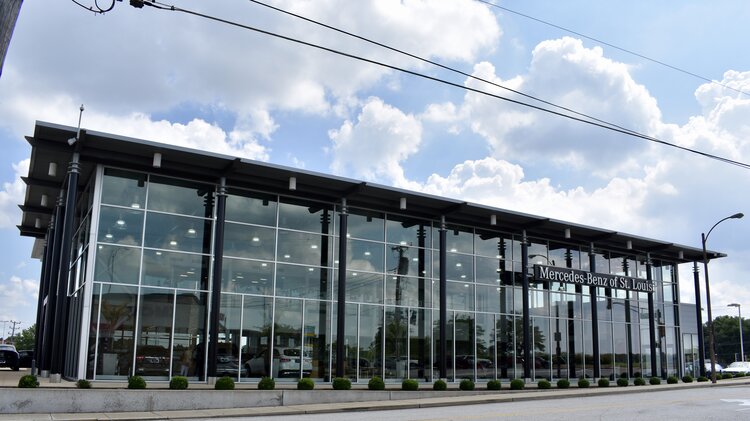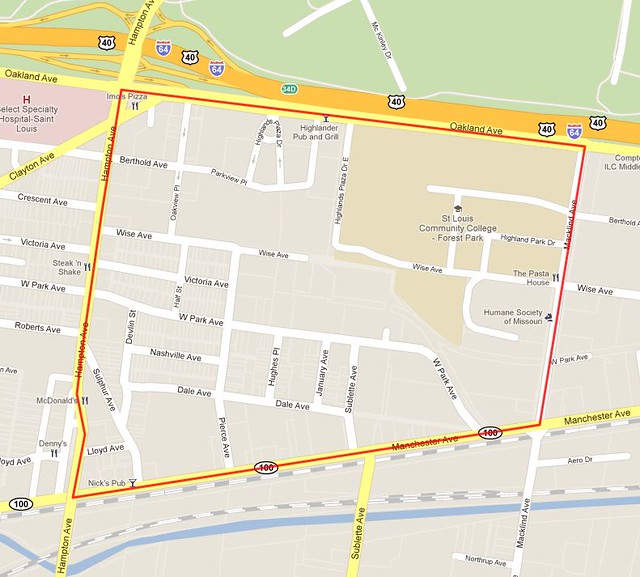
 Cheltenham is a south St. Louis neighborhood bound by Oakland to the north, Manchester to the south, Macklind to the east and Hampton to the west. This is one of the few city neighborhoods to add residents in the past decade. Population increased 29% from a meager 480 residents to 620. The decade saw continued demolition of traditional single family housing, but the Lofts at the Highlands development added residents and led to the increase.
Cheltenham is a south St. Louis neighborhood bound by Oakland to the north, Manchester to the south, Macklind to the east and Hampton to the west. This is one of the few city neighborhoods to add residents in the past decade. Population increased 29% from a meager 480 residents to 620. The decade saw continued demolition of traditional single family housing, but the Lofts at the Highlands development added residents and led to the increase.
The 480 residents counted by the 2000 census (20% decline from 1990s count) were 14% were black, 80% white, 2% Asian and 2% Hisp/Latino. Just 262 housing units were counted, 90% occupied, split 55%/45% owner/renter. Obviously, this is not a largely residential neighborhood, those residential development may be a larger part of its future.
I imagine this will stabilize and maybe even go up a little in the 2010 census counts based on the new lofts at the Highlands development. Most of the houses in Cheltenham are frame homes and exist in the southwest portion of the neighborhood:







^Not sure what the sign above the door means, but it piqued my curiosity.
A little history on this pocket of St. Louis from the city’s website:
The history of Cheltenham goes back to 1798. The area then was known to run from what we now call Kingshighway on the east and went as far as the City limits on the west end. At that time River de Peres was a clear crystal stream. It made a good area for settlements. In later years, immigrants were drawn to the area because they needed work. The factories sprung up with the mining of clay. The earliest and largest of the enterprise was the Laclede Fire Brick Company, which began in 1844., but expanded rapidly with the coming of the railroad. Irish, Italian,German, and Polish immigrants came to wok in the factories. In 1861 the Catholic Diocese established a mission which grew into St. James the Greater Parish. The Cheltenham public school opened in 1868. By World War II, most of the mines had shut down and the brick yards had closed. Subdivisions were built over the mines and pits.
I’m kind of surprised the website doesn’t mention the Highlands Amusement Park or the Arena. The Arena will always be the Checkerdome to me, as this is where I saw my first Blues game, and witnessed a fight hat broke out in the stands….I was hooked. People would be walking to the games through the neighborhood carrying 12 packs of Busch on the way to the old barn. Mullets were commonly sighted.
The original incarnation:


The one I was used to:

Cheltenham was also home to the Highlands, a park that started as a beer garden in 1896 and evolved into an amusement park the operated into the 1960’s when a fire destroyed most of the park on July 19, 1963. It boasted one of the largest public swimming pools in the nation and the roller coasters were huge attractions in their day. There’s an incredible website and a book devoted to the Highlands that chronicles the amusement park’s history. Images here are from that site, but you should visit the site and buy the book (Forest Park Highlands by Doug Garner) to get the full story of the Forest Park Highlands.






You can also view video of some of the Forest Park Highlands roller coasters on YouTube.
You can’t deny the awesome location of Cheltenham. It’s a stones throw to Forest Park, the shopping and services on Hampton Avenue, the access to I-64, the proximity to Barnes-Jewish, the Central West End, Forest Park Southeast and The Grove strip of Manchester. The northern edge of Cheltenham contains the Highlands offices & lofts and Forest Park Community College.



There is a relative new Hampton Inn and 3 office complexes within the Highlands development. There is retail space in one of the office buildings, home to a Jimmy Johns and coffee shop. There is a restaurant/bar called the Highlander and Barnes Jewish has a facility as well:





The lofts are attractive and have surely added some residents to the area:


There are many businesses offices and industries mainly along Macklind and Manchester, but also within the neighborhood:









^I wonder if the lobby smells like onions?



^Tarlton contractors has a facility in Chetenham, kind of reminds me of a fort.
American Pulverizer has a handsome office building along Macklind and a pretty cool sign toward the back of the property:



The Humane Society of Missouri is also located along Macklind:

There aren’t many independent restaurants or bars, but I did come across a few:

^Nicks’ Pub at Manchester and Sulphur.

^The Arena Bar and Grill, I bet this place was jumping when the Checkerdome/Arena was in full swing. This place reminds me of small town bars in New England.
The cool looking firehouse along Manchester:

As you can see, Cheltenham is a mostly industrial neighborhood and is anchored by the Forest Park Community College, Humane Society and the Highlands offices/condos.
Cheltenham used to be home to Fox 2 News along Berthold, right off of Hampton, but they recently chose to abandon the city who they are supposed to be covering, and set up shop in the bland town of Maryland Heights, MO near Page and Lindbergh. It’s like they never left, the satellites and signage is still there:


***In August, 2020 I revisited the neighborhood; the following includes updated commentary and photos.***
Misses On Original Tour
No glaring misses on this one.
Noticeable Changes
The Cortona at Forest Park brought ~278 new apartments to the neighborhood. I visited the Cortona in 2014 when it was still under construction. Pair that with the Encore at Forest Park which brought another ~246 apartments and you have 524 new apartments in Cheltenham. This is why you’ll likely see another bump in population in the 2020 Census count.
These buildings are massive and when we in a work from home environment these days, the parking lots look nearly full.


The businesses are constantly evolving, the loss of the Fox 2 News studio to the burbs brought a new opportunity for a high profile property at I-64 and Hampton, the fourth auto dealership in the city: Mercedes-Benz of St. Louis who built a gorgeous new showroom and dealership.

The other big Cheltenham story of the last ten years is the demo of one of the Forest Park Community College brutalist towers to build make way for a new Health Science building. They appear to be “capping” the section of the former tower they took down.


The brutalist section to the left was torn down recently.

There are a couple examples of newer homes being built in the last ten years, but not many. The homes are still largely the smaller post-war single family structures you see in parts of North Hampton, Walnut Park East and others.

The neighborhood has taken advantage of the speed humps that have come in the last 5-10 years. Traffic calming doesn’t seem like too big of an intra-neighborhood issue.
What Are The Future Needs
The neighborhood likely won’t change just too much aside from businesses coming and going, most of which are auto-centric drive trough situations on Hampton. A dramatic change like Cheltenham has seen from 2010-2020 likely will not continue.
The Forest Park Community College site has an over abundance of surface parking lots which seem to far outpace the student and employee population on campus. I would like to see this campus highlighted as the central gem of the community college system and get some infill on the unused space. The college uses separate buildings on outskirts of the property. It would be ideal to see these offices and spaces move onto campus to make it a more contiguous place.


One of our favorite antique markets, Green Swag, on Manchester is always a fun visit. Manchester could benefit from some streetscape work. Street trees would go a long way to break up the aging post-industrial vibe this part of town has taken on in the last ten years.



